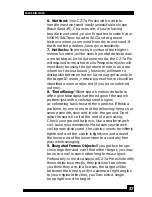
one-way signal or it disappears, move on. Also, if
your pinpointing location is different than your I.D.
location, your target is probably a piece of iron.
Using the small 5-inch coil and/or reducing your
sensitivity level will also reduce the number of false
signals caused by trash.
2. Deep Targets:
Deep targets. just barely within the
range of the CZ-7a Pro, may be misidentified. For
example, a deep coin may I.D. as iron or a deep
piece of iron may I.D. as a coin. There's not much
you can do to avoid this other than to use your
pinpoint mode to ensure that you are exactly
centered over the target. Or you may reduce your
sensitivity level so you just ignore the very deepest
targets. Fortunately, misidentification of deep
targets is not what usually happens. It's the
exception to the rule.
3. Electrical Interference:
Constant chatter caused
by radio/TV stations, power lines or nearby detectors
operating at one of the CZ-7a Pro search
frequencies. The best solution is to move away from
the source of the interference. You may also try one
of the following: Switch to the Autotune mode.
Reduce your sensitivity level. Slow down your sweep
speed. If the interference is only minimal and you
wish to continue searching anyway, test your CZ-7a
Pro over a known target to make sure it's operating
properly. Inside some buildings, electrical
interference may be so bad that you'll have to go
outside just to bench test your CZ-7a Pro.
4. Highly Mineralized Soil:
May cause a belltone
response or constant false signals. Check your
ground balance (better yet, ground balance using
the "Bobbing" method) and make sure your
detector is in the ID search mode. Then try lowering
the sensitivity. Use a smaller search coil. Search in
the Autotune mode. If all else fails, raise the search
coil just high enough for the false signals to
disappear and then sweep at that constant height.
5. Black Sand:
Same as Highly Mineralized soil.
FALSE SIGNALS
36











































